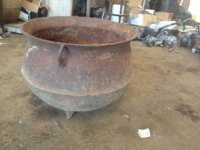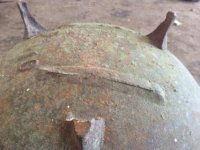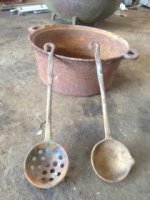Hello there! My first post here. I work in a metal recycling facility and come across a good bit of cast iron tubs, kettles, pots, pans, etc. I was hoping to get some information about a few pieces that came in recently. First is a kettle/cauldron that measures 16" in diameter and 14" tall. It has one broken foot. There's a 10 stamped on the bottom.
Second is a pot that measures 10" in diameter and 4.25" tall. Has "16" and "OVEN" on the bottom.
Lastly are some utensils that appear to be made in Taiwan. They measure 11" long.
Thanks in advance! I'm looking forward to learning about cast iron from this site!
Ryan
Second is a pot that measures 10" in diameter and 4.25" tall. Has "16" and "OVEN" on the bottom.
Lastly are some utensils that appear to be made in Taiwan. They measure 11" long.
Thanks in advance! I'm looking forward to learning about cast iron from this site!
Ryan



